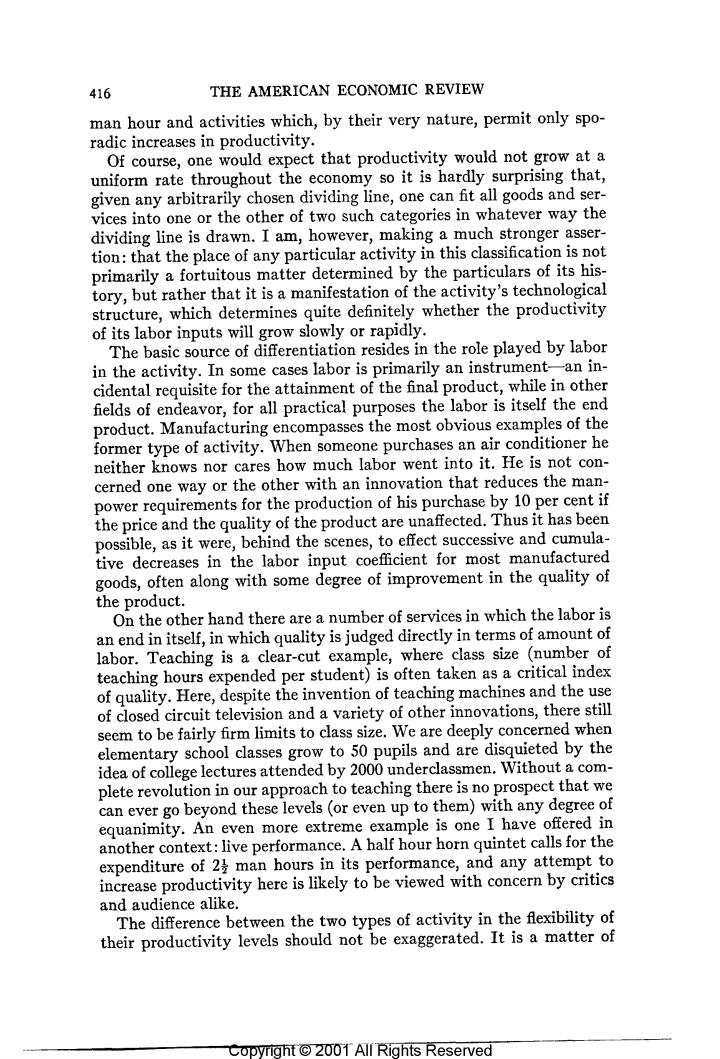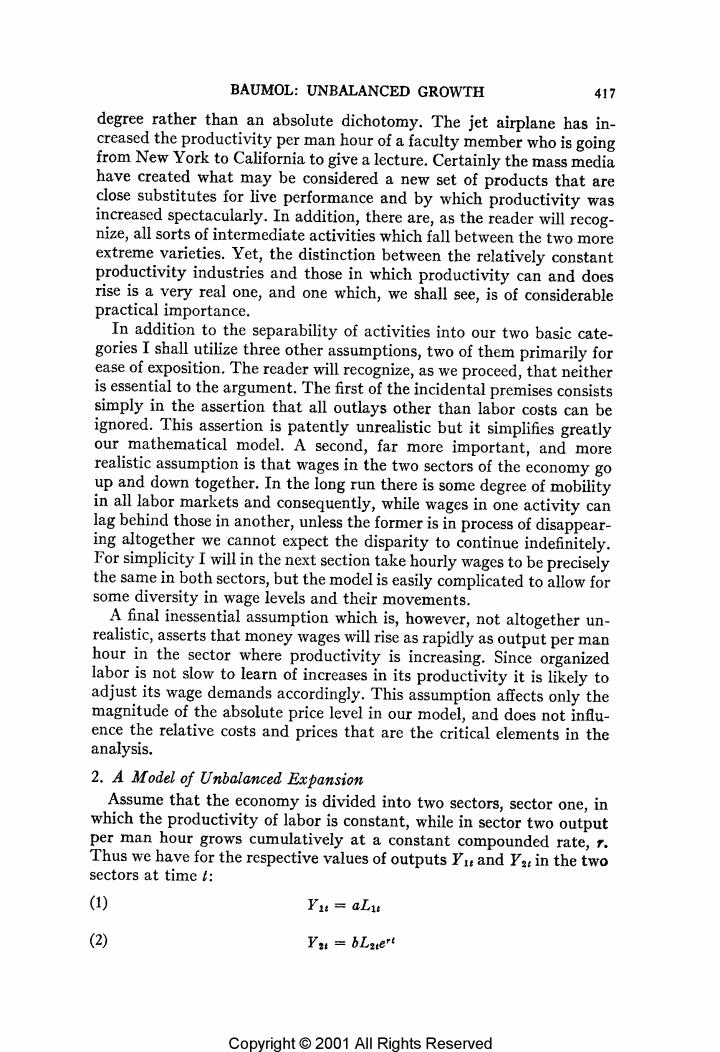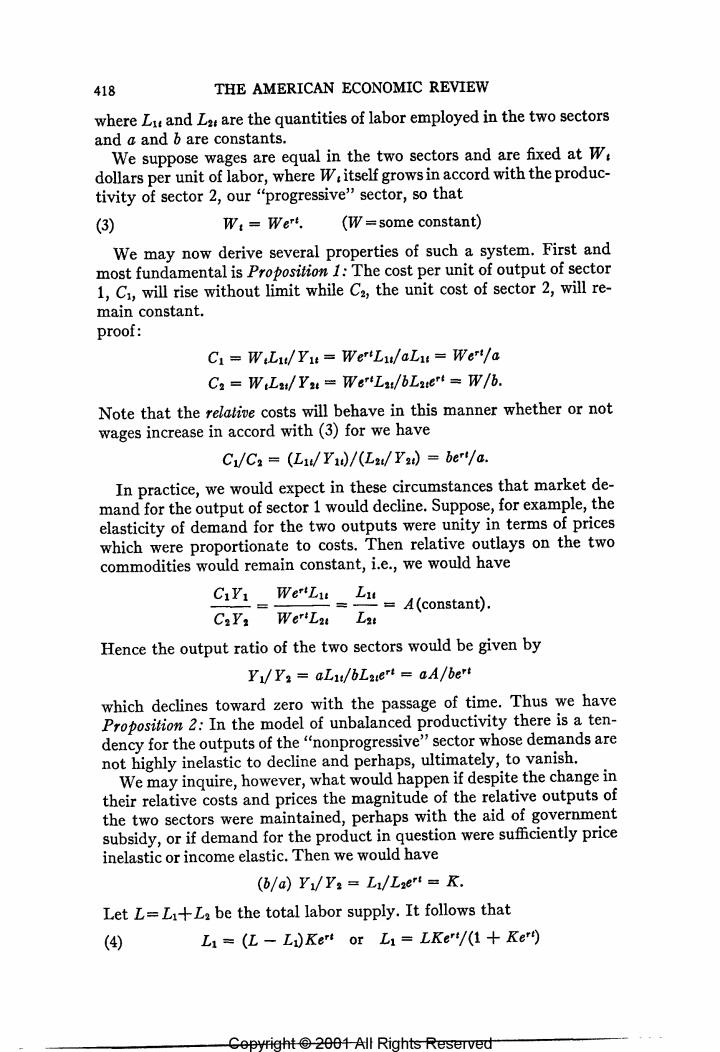
MACROECONOMICS OF UNBALANCED GROWTH: THE ANATOMY OF URBAN CRISIS* By WILLIAM I.BAUMOL There are some economic forces so powerful that they constantly break through all barriers erected for their sur ample,are the forces of supply and demand which haver medieval efforts to abolish t sted alik and co mpts to contro at I belie the futur ored the past and seems likely to stamp its characteron .It helps us to understand the prospective roles of a wide variety of economic services:municipal government,education,the per- forming arts,restaurants,and leisure time activity.I will ar gue that inherent in the technological structure of each of these acttesr forces working almost unavoidably for p sive and cumulative in creases in the real costs incurred in s ing them As a c equence. efforts to offset these cost in may succeed temporar- in the merely palliatives which can have no significant on th erlying trends. The justification of a macroeconomic model should reside primarily in its ability to provide insights into the workings of observed phenome Its aggregation of diverse variables usually deny it the elega nce and the rigor that are provided by microeconomic analy sis at its he models have succeeded in exp plaining the structu and in offerin guidance for policy egre far eluded th ore pa stak des at has so th e trad of economic analysis.This article hopes to fol- 1t1 the structure of its basic model is rudimentary. Yet it can perhaps shed some light on a variety of economic problems of our generation. 1.Premises Our model will proceed on several assumptions,only really essential.This basic premi not entirely arbitrarily, s that ecor activities can, gressive o two types:technologically pro activities in novations,capi tal accumulation.and economies of large scale all make for a cumulative rise in output per ◆The author i Ford Found ants 1am rming arts c every cas the data bave doc support Copyright2001 All Rights Reserved

416 THE AMERICAN ECONOMIC REVIEW man hour and activities which,by their very nature,permit only spo- radic increases in productivity. one would expect that productivity would not grow at a uniform rate thro ghout the economy so it is hardly surprising that, given any arbitra chosen line,one can fit all goods and ser- two such cat gories in whatever way the dividing line is drawn.I am,however,making a that theplace ofny rcs is not primarily a fortuitous matter determined by the particulars ory butather thatitsfestation of theacti t which determines quite definitely whether the productivity of its lab por inputs willg w slowly or rapidlv. The basic ce of d entiation resides in the role played by labor in the activity. nent-an in cidental requisite for the attainme of the while in other fields of endeavor,for all practical purposes the is itself the end product.Manufacturing encompasses the most obvious exam es of th former type of activity.When someone purchases an air conditioner h neither knows nor cares how much labor went into it.He is not con cerned o e way or the other with an innovation that reduces the man power requi nts for the production of his purchase by 10 per cent if the price and the qu 4 f th e product are unaffected.Thus it has been Dossible.as it were the scenes,to effect su uccessive and cumula- tive decreases in the labor input coe anufactured goods,often along with some degree of improvement in ality the product. On the other hand there are a number of services in which the labor is nd in itself in which quality is iudged directly in terms of amount o ng is a clear-cut example,where class size (number of teaching hours expe nded r student)is often taken as a critical index of quality.Here,de pite of teaching machines and the use of closed circuit televi on and a a variety c othe, nnovations,there still seem to be fairly firm limits to class size.W are ed wher elementary school classes grow to 50 pupils and are dis ed by the idea of college lectures attended by 2000 underclassmen.Withou plete revolution in our approach to teaching there is no prospect that we an eve r go beyond these levels(or even up to them)with any degree of other 巧少. An even more extreme example is one I have offered text.liv e performance.A half hour horn quintet calls for the 0 expenditure increase produ and audience alike. The difference between the two types of activity in the flexibility of their productivity levels should not be exaggerate ed.It is a matter of

BAUMOL:UNBALANCED GROWTH 417 degree rather than an absolute dichotomy. The jet airplane has in- yper man hour of a faculty member who is going California to give a lecture.Certainly the mass media have created what may be considered a new set of products that are close substitutes for live performance and by which productivity was increased spectacularly.In addition,there are,as the reader will rec nize,all sorts of intermediate activities which fall bety cog the extreme varieties.Yet,the distinction betw ween the two more productivity industries and those in latively constant h productivity canand does ,and one which,we,of coniderable pr actical importance. In add ition to the separability of activities into our two basic cate- gories I shall utilize three other assumptions,two of them primarily for ease of exposition.The reader will recognize,as we proceed,that neithe is essential to the argument.The first of the incide ys other emise simply in the assertion that all outla consi or ignored.This assertic costs can n ie tently unr d。 c but it simplifies greatly mati A second,far more important.and more assumption is that wages in the two sectors of the economy go up an down together.In the long run there is some degree of mobility in all labor markets and consequently,while wages in one activity can lag behind those in another,unless the former is in process of dis ing altogether we cannot expect the disparity to contin For simplicity I will in the next se tion tak the same in both urly wages to be precisely sectors but the n odel is easily complicated to allow for wage levels and their movements. A final inessential assumption which is,however,not altogether un- realistic,asserts that money wages will rise as rapidly as output per man hour in the sector where productivity is increasing. Since organized labor is not slow to learn of increases in its productivity it is likely to adiust its wage demands according ly.This assu mption ects onl th magnitude of the absolute ice and does not influ- ence the relativ cost l in our model, s and prices that are the critical elements in the analysis. 2.A Model of Unbalanced Expansion Assume that the economy is divided into ty which the productivity of lab sectors,sector one,in constant,while in sector two output per man hour Thus we ha s cumulati at a constant compounded rate.r. ve for the respective valucs of outputs and in the two sectors at time: (1) Yu=aLu ® Ya =bLztert Copyright2001 All Rights Reserved

418 THE AMERICAN ECONOMIC REVIEW where L and La are the quantities of labor employed in the two sectors and a and b are constants. We suppose wages are equal in the two sectors and are fixed at We dollars pe unit of labor,where W:itself grows in accord with the produc- tivity of sector 2,our"progressive"sector,so that Wi=We". (W=some constant) We may now derive several properties of such a system.First and most fundamental is Proposition 1:The cost per unit of output 1,Ci,will rise without limit while Ca,the unit cost of sector 2,will re- main constant. proof: C1=WiLu/Yu=We"Lu/aLu Wer!/a Ca=WLa/Y=We"La/bLate"!=W/b. Note that the relative costs will behave in this manner whether or not wages increase in accord with (3)for we have Cv/Ca=(L/Y)/(La/Y)=be"!/a. In practice,we would expect in these circumstances that market de mand for the output of sector 1 would decline.Suppose,for example,the elasticity of demand for the two outputs were unity in terms of prices which we re prop ortio nate to costs.Then relative outlays on the two commodities would remain constant,i.e,we would have c_-0 Lu(constant). Hence the output ratio of the two sectors would be given by Y1/Y:=aLut/bLate"t aA/bert which declines toward zero with the passage of time.Thus we have Proposition 2:In the model of unbalanced productivity there is a ten- dency to or the ts of the"nonprogressive"sector whose demands are c to decline perha ultimately,to vanish. We may inquire,however,wh t wo n if despite the change in their relative costs and prices th e magnitud elative outputs of the two sectors were maintained,perhaps with the aid of nment bymndothe prodcteruntprice inelastic or income elastic.Then we would have (b/a)Y1/Y:=L/Le"t K. LetL=L+La be the total labor supply.It follows that (④) L=(L-L)Ke"t or L LKe"t/(1+Ke") epyright2001-All Rights Reserved

BAUMOL:UNBALANCED GROWTH 419 and (5) L:=L-L:=L/(1+Ke" 女22 zero.Thus of the outputs of the two sectors is held constant, more and more of the total labor force must be transferred to the non- progressive sector and the amount of labor in the other sector will tend to approach zero. Finally,we may note what happens to the output in the economy if the o mitted to change.Wen utput aouytake as an index of output a weighted aver- e two sectors: I=BiY1+BaYa BaL+BabLaert so that by (4)and (5) I=L(KBa+B2b)e"t/(1+Ke")Re"!/(1+Ke") where R=L(KB1a+B26). Therefore dI/dt =R[re"t(1+Ke")-Kreart]/(1+Ke) rRe"t/(1+Ke)2. As a result,the percentage rate of growth of output will be (dI/dt)/I=r/(1+Ke) which declines asymptotically.We have,then, arrived at Proposition 4:An dedinimg at achieve balanced growth in a relativ to ductiv the rate of growth of the labor force.In particular,if pro- ity in o sector and the total labor force remain constant the growth rate of the economy will asymptotically approach zero. 3.Discussion of the Propositions The logic of the entire analysis can be restated rather simply in intui tive terms.If productivity pe man hot es cumulativelyi In one sector relative to its rate of gro wth elsewher the ec commensurately in all a ,the omy,while wages rise elative cost s in the nonprogressive sectors must inevitably ,and these costs rise cmatieynd ithout limit For while in the progressive sector productivity increases will serve as an offset to rising wages,this offsetmust be maller in the Copyright2001 All Rights Reserved